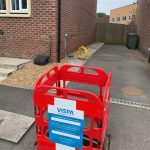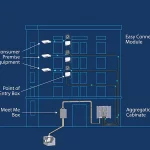Ofcom Tells BT to Improve 10Mbps UK Broadband USO Quotes

Ofcom’s investigation into BT’s compliance with their obligations under the new Universal Service Obligation (USO) for broadband has concluded that “some customers have been asked to pay materially higher amounts than they should have been.” As a result, they’ve asked the ISP to make a few improvements.
The USO, which was officially introduced one year ago, is aimed at those who can’t yet receive a 10Mbps+ capable download speed and aren’t currently planned to in the near future. At present around 0.6% of UK premises (180,000+) fall within the USO’s scope – this reflects those living too far from both fixed line, fixed wireless and suitable 4G mobile coverage.
However, last year we reported on various examples (here) where people had been hit with quotes for excess costs that ran from tens of thousands of pounds and all the way up to well over £1m. Often this has been exasperated by issues of mixed messaging and inconsistencies in the quotes themselves. Suffice to say that the accuracy of BT’s quotes and how they’re pieced together came in for a lot of scrutiny.
Advertisement
Ofcom soon launched a related investigation into the issues (here) and the Government’s Digital Infrastructure Minister, Matt Warman MP, similarly called on both sides to find a “resolution” (here), which at the time we warned would be easier said than done.
The biggest obstacle here is that it remains an inherently difficult task to accurately estimate the cost of a fibre optic rollout in areas where no good fixed line or wireless solutions exist. At the same time, there are some very real cost barriers involved, which cannot simply be swept aside by good intentions or small tweaks.
What has BT done so far?
At the time of the last update we speculated that Ofcom would probably seek to improve how the costs of USO connections are calculated and or shared between properties. Earlier this year BT introduced a cost sharing “option” for their USO quotes (here), which enables communities to “crowdfund and share the excess cost of a broadband network upgrade“ (preferable to lumping all the costs on to the first accepted quote / home).
In addition, if more than 70% of premises in a cluster register their interest, a contribution of an “additional £3,400 per premise” is included, lowering any excess costs that the community may have to pay (it’s quite tricky to get this right and requires a lot more organisation).
Advertisement
On top of that, the 4G solution that BT ships in response to most USO requests now come with unlimited data usage (some people can also get an external antenna installed, if deemed necessary). Finally, BT states that they’ve improved their processes and reduced complaints.
The regulator’s conclusion
Naturally, we weren’t expecting Ofcom’s investigation to result in a magic wand that could resolve the many inherent cost problems involved in deploying fibre optic broadband to extremely remote areas, which largely just reflects the reality of how much these networks cost to build. Indeed, in some very remote areas it would be cheaper to build somebody a new house, in a better connected area, than to run a new fibre line to them.
Suffice to say that the regulator recognised that BT had agreed to change its approach for quotes where the cost of connecting a property is not significantly above the £3,400 threshold. BT has also agreed to refund affected customers and re-issue quotes it has previously provided. “We have therefore suspended our investigation, but will monitor BT’s actions closely to ensure our concerns are addressed,” said Ofcom.
• Where excess costs are very high, BT can recover total excess costs before commencing build. When one customer makes a request, and excess costs are more than £5,000 (excluding VAT) per eligible premises based on the forecast assumption of 70% take-up in the area, BT should inform customers of the total excess costs and gain agreement to cover these before building.
One or more customers can cover all the excess costs of the build, including shared infrastructure. We expect that very few customers will be willing to pay more than £5,000 (excluding VAT) to receive an upgraded broadband connection under the USO, so this change should have a very limited impact on customers, while reducing any risks on cost recovery.
• No changes for the assessment of premises where excess build costs are £5,000 (excluding VAT) or below. Where excess build costs are £5,000 (excluding VAT) or below, based on a forecast of 70% take-up, customers’ quotes should be based on this assumed take-up. BT must then provide any connection where a customer agrees to pay their quote. As a result of our investigation, BT has now agreed to apply this approach.
Ofcom are not proposing any other change to the existing rules on how BT must assess USO connection costs. The regulator is also not proposing to make this same change for KCOM, given the availability of decent broadband services in the Hull Area. “We note that, to date, KCOM has not received any requests from USO eligible customers,” added Ofcom.
Advertisement
BT’s assurances should result in a number of customers receiving lower quotes in the future, but the regulator rightly recognises that the cost of connecting some properties – including those in the most remote parts of the UK – will remain very high.
The Government’s new £5bn Project Gigabit programme has similarly warned that those in the final 0.3% would be prohibitively expensive to reach (here) and they’re now consulting on how to resolve this (we expect new wireless networks and LEO satellites to be options), which may ultimately help to provide another solution to the USO problem (e.g. support for more fixed wireless networks or LEO based broadband satellites).
A BT Spokesperson said:
“As the designated provider of the Government’s Universal Service Obligation scheme, we’re working hard to connect many premises to decent broadband speeds, often surpassing requirements by delivering full fibre connections to them, as well as supporting communities with options to help fund their local builds by sharing costs.
We’re committed to delivering connectivity to even more properties and welcome the recent constructive conversations with Ofcom, including their proposals to suspend their investigation whilst they seek to amend the scheme. Connecting homes in the most remote locations under the terms of the USO remains highly complex and extremely costly, and for these premises a different solution will be required.”
The consultation on this will run until 10th September 2021 and Ofcom intend to then publish their final decision by the end of 2021, which seems unlikely to change much from what is written above.
UPDATE 3:14pm
One potential issue that we can see in Ofcom’s new approach occurs “where excess costs are £5,000 (excluding VAT) or less per premises, BT must connect customers on request if there is agreement that the excess costs relevant to their premises will be paid” (3.26 in Ofcom’s consultation). In short, eligible USO builds would be triggered through the first request and then built out to all the properties in that cluster, regardless of whether they’ve all contributed.
On the surface this is a good thing, for consumers, as the infrastructure gets built up front (at least in part). But digging deeper (no pun intended), this also fosters a situation that, further down the road, could cause confusion and frustration for consumers.
People will see the network being built and assume they can just request it at minimal cost, albeit without realising that they may still need to pay up to £5k +vat before they can connect (i.e. this is partly how Ofcom makes the shared costs approach work, since not everybody will always apply to share USO costs in an area at the same time).
Suffice to say, BT may end up taking the blame for an approach that Ofcom has required them to adopt when people run into such issues. In fairness, and much as we said earlier, this was never going to be an easy problem to solve.
Mark is a professional technology writer, IT consultant and computer engineer from Dorset (England), he also founded ISPreview in 1999 and enjoys analysing the latest telecoms and broadband developments. Find me on X (Twitter), Mastodon, Facebook, BlueSky, Threads.net and Linkedin.
« ISP TalkTalk Bundle Amazon Smart Kit with UK Fibre Broadband






















































The modelled risk in the consultation document to BT is between £14m and £84m for all 66.5K premises a fraction of the monies owed to BDUK. £37m alone was added to the Capital Deferral. This is not a problem that cannot be solved.
Ofcom by failing to examine the interaction between vouchers, monies owed and existing contracts have missed an opportunity to nail this, but the number of customers is small and not the 1.6m customers folk were modelling in 2016.
The big finding was BT was not dividing the costs in a manner Ofcom expected. That’s the source of the high costs and extends to how fibre on demand was being managed. There was also nothing on the volume of these quotes.
A diversion of a fraction of the monies owed would mean a significant outcome, not just for these premises but all the surrounding communities and land.
That money is owed to local authorities. It’s not a general fund for BT to spend on network expansion. It can’t simultaneously be BT’s money to spend and not BT’s money to spend. Local authorities will spend it on whatever they choose to spend it on.
“and extends to how fibre on demand was being managed.”
FTTPoD is pretty much a dead product for all practical intents and purposes.
@NGA
To repeat earlier responses to the many times that you have posted something along the lines of your above message regarding BDUK funds, each local authority decides how to use any monies that it gains via the BDUK clawback mechanism. Given current budget challenges, I doubt many will prioritise further broadband investment over their statutory responsibilities.
That’s only half the money, the other half is controlled by BDUK.
What we really need is Ofcom to review all of the BT’s capital contribution to subsidised using the ‘fair bet’ principals. The principal of gap funding should be checked. Cost were inflated, NAO -2015, permitting BT capital to be with-held, as we learn here BT can cost the more difficult in a manner in order to avoid having to do it.
The modelled risk of £14-£85m costs is less than the capital contribution owed for overbuilding 1.1m of Virginmedia customers using state aid.
@NGA – do you have the agreed calculations regarding overbuild?
@facts Think Broadband provided the 1.1m calculation and the multiple comes from Ofcom’s fair bet analysis model for WLA in 2017.
@NGA – link to Ofcom analysis please. The >100 ISPs benefited more than OR from overbuild.
@The Facts Overbuilding commercial build is illegal in state aid terms. Your can find the Cartesian fair bet models at Ofcoms WLA review for 2017.
What possible relationship has an illegal diversion of state aid to do with retail ISP’s? It provides justification for the matter to be fixed.
£45/month on a 24 month contract for 15Mbps via 4G seems like it’s keeping to the letter of the law but far from the spirit of it, even if it now doesn’t have a data allowance attached to it.
Uso on 4g I always wonder just how much work was really involved, and how many would have been solved by the customer just buying a 4g router and a better priced olan
That’s lies over a year I have had issues with bt and still nowhere near a suitable Internet connection and it’s keeps cutting out 1900 yards to my nearest exchange fttp available but in 2025 ridiculous oh and 10mb download and 1 my upload for £45pcm
They should remove the 4G option for larger metropolitan areas. I know a few people struggling to hit >5Mbps and they live very built up area’s BT have just skipped some streets for whatever reason in the past.
I would tend to agree with that.
4G was intended for rural and ultra rurals not urban not spots.
Here is an idea, rather than hoping that The private sector will build universal infrastructure and then heavily subsidising them till they do, why not find the infrastructure and thereby it out? Or privatise the service at a future date? I wonder if any govt has done this in the past?
*fund the infrastructure and then hire it out. autocorrect!
Unfortunately it’s a bit too late for that, though it would have made sense years ago.
You don’t have multiple water pipes or power lines from different infrastructure companies going into the same premise, yet there a places where fibre infrastructures to the premises were duplicated, sometimes even tripled, in certain areas, while large parts of this country doesn’t yet have fibre broadband at all.
Governments can borrow money to build capex intensive infrastructure at much lower rates than private companies. If they did do that they would send the commercial fibre providers bankrupt – and they would be sued to hell and back for doing it. The WTO takes a dim view of governments doing this in any field.
BDUK was an exception, because the government only paid for work to be done where there was no reasonable prospect of a commercial rollout and even that has a clawback clause where the subsidy is returned if takeup makes an area become commercially viable.
This helped to overcome a problem where providers with significant market power (definitely Openreach but potentially also Virgin) would be breaking the Competition Act if they delivered service below cost to rural areas with the effect of freezing out other providers.
“Governments can borrow money to build capex intensive infrastructure at much lower rates than private companies.” Well, that’s what happened in countries like Autralia with the NBN (though it was watered down from the original FTTP to the current MTM approach).
I tried the USO route.. ended up with a £214k quote for FTTP – they didn’t even offer the 4G option!
After asking for more details, a solid proportion was put on project management costs / planning (20k) along with 150k of “fibre cable costs”. Interestingly the civil engineering was quoted as a different line item (19k) so unless they are going to an exchange different to the one that is 2 miles away – it feels like there is strong markup on that fibre!
Not sure many would accept the USO option with quotes like this!
It appears Ofcom will oblige BT to re-quote you using this ne shared methodology. Perhaps vouchers could be used. There are residual amount of premises to be delivered in most counties. There is clawback owed everywhere, so it remains possible.
The exchange may not be relevant.
It is run from the appropriate node which may well have nothing to do with the exchange.
Is there FTTC within the 2km? If there is FTTC there is fibre. And if there is fibre there may well be spare fibres.
again complete misunderstanding how how FTTP is delivered against FTTC. Each supposed USO will have been mapped to determine what technology is suitable for that premise which which s why you either get a 5G or an FTTP. FTTC is based on Blown fibre tubing , FTTP is based on on getting a fibre path back to the Headend in rural exchanges that may be no where near the exchange you are connected to which which is why the numbers are as they are The FTTC mostly is a red herring) — Clawback is irrelevant as this is nothing to do with BDUK
@Fastman: Wasn’t FTTC originally meant to be a first step in bringing fibre closer to the premises (that is, to a cabinet), with the ability to upgrade from there to future full fibre? Or has this approach been abandoned now?
Gnewton
the former yes brings fibre closer that it was
your comment with the ability to upgrade from there to future full fibre? there has never been an ability to extend on from cabinet (thats a misnomer and a red herring) it have to come back to an aggregation node in every situation, but with FTTP you have to find a pat back to a Headend which is not the same as FTTC
@Fastman: So you are saying that the FTTC fibre infrastructure (up to the cabinet) was never suitable for future fibre upgrades? We were frequently told in the past that the former FTTPoD (when it was available in realistic terms) used to be from the cabinet’s nearest aggregation node to the end premise. Is Openreach not using already existing fibre ducts anymore for upgrades?
Even in backwards countries like Australia NBN recently started offering upgrades from FTTC to FTTP for customers ordering higher speed lines.
48 fibre cable to the FTTC cabinet in this village.
@fastman, the interaction between BDUK and B-USO is in the act. It provides a 12 month overlap, it should be more given how slow BT is bringing these works to a conclusion.
Clawback provides the option to do more work so it is always relevant and was intended to complete rural work.
The spare sub-duct is relevant and the spare fibres serving cabinets is relevant. Co-locating a splitter adjacent to a cabinet is important to BT in now quoting £300-£400 cost for all 6.2m area customers.
Ofcom found BT has been mis-quoting for these works. This is the principal finding and something that will extend to all FTTP FoD and your own activity.
Gnewton you have to go back to the aggregation node that might be significant distant form the Cabinet there might be one aggregation node covering a number of cabinets over a significant distance. and from that agrregation node you have to get to a suitable headend
And it is mostly in place in rural paid for by the public purse. It is easy to extend and this is reflected in BT confirmation in its press to the City that cost for the 6.2m will be the same £300-£400 as per urban build.
Ofcom were gentle with BT here. The same mis-use of FOD FTTP in NI resulted in a large fine.
@Fastman I hope BT takes the opportunity to check its capital contributions to each and every CBP quote and reimburses or extends where necessary. The same should apply to all those profiting from vouchers.
Perhaps this work can form the basis of defining a ‘reasonable request’ something BT is obliged to respond to in a consistent way.
Can you explain why BT stopped providing a full record of the Capital Deferral in its accounts this year?
NGA really ?